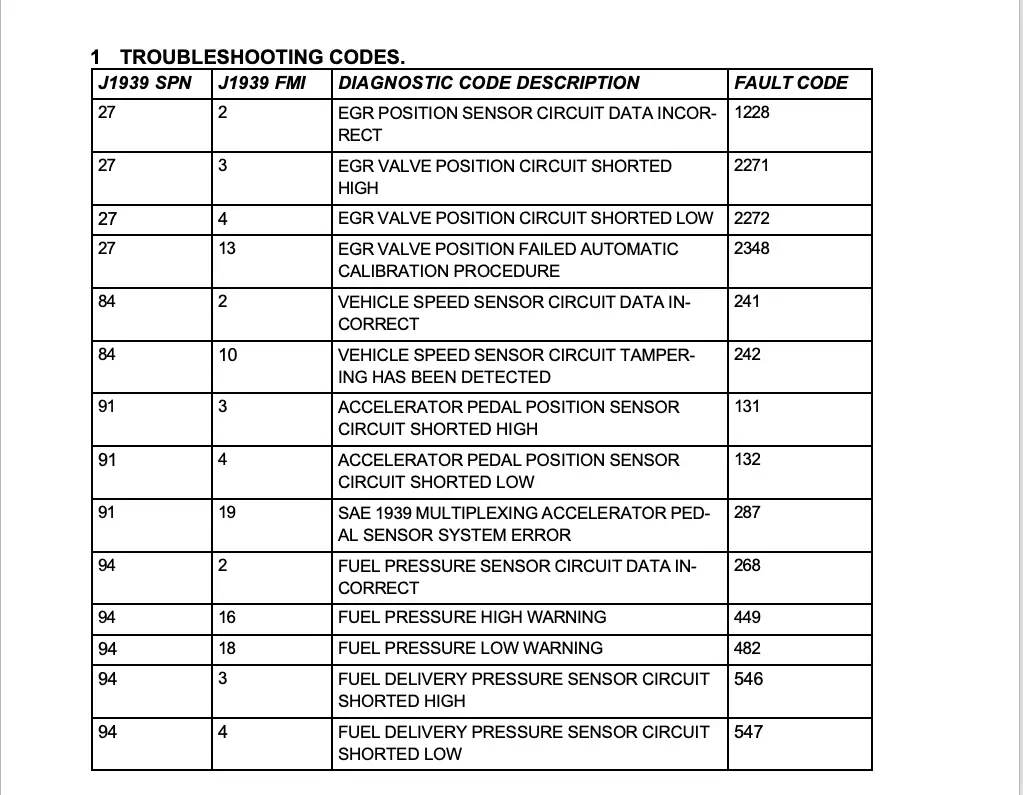The FMI Codes List provides diagnostic trouble codes for identifying issues in vehicle electronics systems. This list categorizes malfunctions related to specific areas of the vehicle.
Understanding these codes is crucial for efficient troubleshooting and repair of vehicle issues. By utilizing the FMI Codes List, mechanics can pinpoint the root cause of a problem quickly, leading to faster repairs and minimized downtime for the vehicle. Having access to this comprehensive list of codes streamlines the diagnostic process, ultimately saving time and money for both mechanics and vehicle owners alike.
Credit: ferienwohnung-schneggeeck.de

Understanding The Fmi Codes List
What Is Included In The Fmi Codes List?
The FMI (Failure Mode Identifier) codes list includes specific diagnostic trouble codes that help identify issues in machinery and equipment.
These codes provide detailed information on the nature of the problem, aiding in efficient and accurate troubleshooting.
How Are The Fmi Codes Categorized?
- Category 1: FMI codes related to data valid but below normal operational range.
- Category 2: FMI codes linked to data valid but above normal operational range.
- Category 3: FMI codes associated with data erratic, intermittent, or incorrect.
- Category 4: FMI codes indicating a mechanical system failure.

Credit: www.jlg.com
Common Fmi Codes
Fault Mode Indicator (FMI) codes are essential for diagnosing issues in various systems. Here are some of the most common FMI codes that you may encounter:
Fmi Code 1: Abnormal Frequency Or Pulse Width
Indicates irregularities in the frequency or pulse width of a signal, leading to potential performance issues.
Fmi Code 2: Abnormal Data
Highlights discrepancies in the data being processed, affecting the accuracy of the system’s operations.
Fmi Code 3: Voltage Above Normal
Denotes voltage levels exceeding the standard range, which could pose risks to the equipment’s functionality.
Fmi Code 4: Voltage Below Normal
Shows voltage readings below the expected threshold, impacting the system’s ability to operate efficiently.
Fmi Code 5: Current Above Normal
Flags instances where current levels surpass the normal parameters, potentially causing equipment strain.
Fmi Code 6: Current Below Normal
Signals abnormally low current flow, which may indicate connectivity issues or component malfunction.
Fmi Code 7: Mechanical System Failures
Points towards failures within the mechanical system, necessitating immediate attention to prevent further damage.
Fmi Code 8: Abnormal Frequency, Pulse Width, Or Period
Implies irregularities in the signal’s frequency, pulse width, or period, affecting the system’s performance.
Fmi Code 9: Abnormal Update Rate
Highlights deviations in the update rate of data, potentially affecting the system’s real-time monitoring capabilities.
Fmi Code 10: Abnormal Rate Of Change
Indicates rapid and irregular changes in system parameters, requiring investigation to pinpoint the root cause.
Fmi Code 11: Root Cause Not Known
Denotes a situation where the exact cause of the fault is uncertain, necessitating further analysis to identify the issue.
Troubleshooting Fmi Codes
In the world of machinery and equipment, FMI (Failure Mode Identifier) codes play an important role in diagnosing any potential issues. These codes provide valuable information about the underlying problem, helping you identify and resolve the issue efficiently. In this section, we will guide you through the process of troubleshooting FMI codes to get your equipment back up and running smoothly.
Step 1: Understanding The Fmi Code Meaning
Before you can effectively troubleshoot an FMI code, it is crucial to understand what the code represents. Each FMI code corresponds to a specific failure mode, giving you insights into the exact nature of the problem. For example, an FMI code of 1 may indicate a data valid but below normal range issue, while an FMI code of 4 may point towards a mechanical system failure.
Step 2: Identifying The Possible Causes
Once you have grasped the meaning behind the FMI code, the next step is to identify the potential causes. This requires a thorough understanding of the machinery or equipment in question and its associated systems. Consulting the manufacturer’s documentation is often helpful in this process, as it can list the common causes for each FMI code.
Step 3: Checking For Common Issues
After narrowing down the possible causes, it’s time to check for common issues that may be triggering the FMI code. This includes examining the connections, hoses, wiring, sensors, and any other relevant components. Look for signs of damage, wear, or loose connections, as these can often be the culprit behind FMI codes.
Step 4: Consult The Manufacturer’s Documentation
If the common issues check doesn’t yield any results, don’t worry. The manufacturer’s documentation is a valuable resource that should not be overlooked. It may contain specific troubleshooting steps for each FMI code, helping you diagnose and resolve the problem more accurately. Follow the recommended procedures carefully and systematically to ensure a comprehensive troubleshooting process.
Step 5: Seeking Professional Assistance
If all else fails or if you are unsure about the next steps, it’s always wise to seek professional assistance. Qualified technicians and experts have the experience and knowledge to handle complex FMI code issues effectively. They can utilize advanced diagnostic tools, perform in-depth inspections, and provide guidance on the best course of action to take. By involving professionals, you can ensure a swift and accurate resolution to the problem, minimizing downtime and maximizing productivity.
Preventive Measures
Regular Maintenance
Regular maintenance is essential for keeping FMI codes at bay. By conducting regular checks and servicing of the equipment, you can identify and rectify any potential issues before they escalate. This helps prevent the occurrence of FMI codes and ensures the machine operates smoothly.
Monitoring System Performance
Continuous monitoring of the system’s performance is crucial. By regularly analyzing the data and identifying any irregularities or anomalies, you can take proactive measures to prevent the occurrence of FMI codes. This can also help in predicting potential issues and addressing them early on.
Proper Training For Machine Operators
Ensuring that machine operators are properly trained is vital in preventing FMI codes. Comprehensive training equips operators with the necessary knowledge and skills to operate the machinery efficiently, minimizing the risk of errors that can lead to FMI codes. This also helps in promoting a safety-oriented culture and reduces the likelihood of code occurrences.

Credit: www.wholefleet.ca
Frequently Asked Questions Of Fmi Codes List
What Are Fmi Codes Used For?
FMI codes, or Failure Mode Identifier codes, are used to provide specific information about the fault that caused a diagnostic trouble code (DTC) to be set. They help technicians to pinpoint the exact issue within a vehicle’s system.
How Do I Interpret Fmi Codes?
Interpreting FMI codes involves understanding the specific meaning of each code in relation to the associated diagnostic trouble code (DTC). By analyzing the FMI code along with the DTC, technicians can diagnose the exact nature of the fault within the vehicle’s system.
Where Can I Find A Comprehensive Fmi Codes List?
A comprehensive list of FMI codes can often be found in the service manual or technical documentation provided by the vehicle’s manufacturer. It can also be obtained through reputable online resources or diagnostic software used by automotive professionals.
Conclusion
From this comprehensive FMI codes list, it is evident that these diagnostic trouble codes play a crucial role in detecting and resolving engine issues. By understanding the meaning behind these codes and their corresponding symptoms, you can effectively diagnose and troubleshoot problems in your vehicle.
Remember, using a reliable scan tool and referring to the manufacturer’s manuals are essential for accurate interpretation. Stay informed and proactive in maintaining your vehicle’s performance with the help of FMI codes.